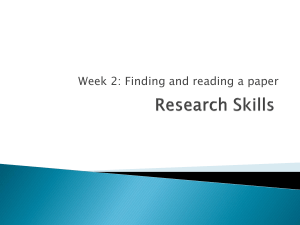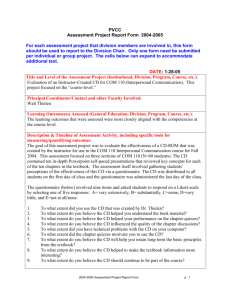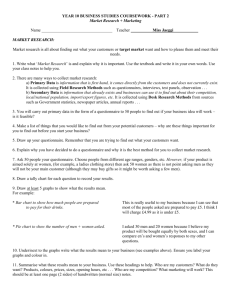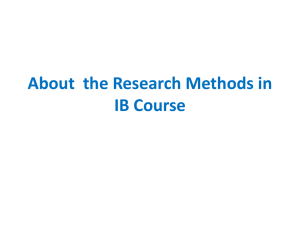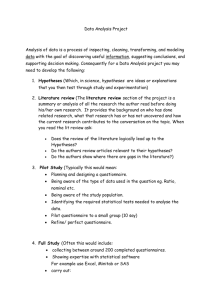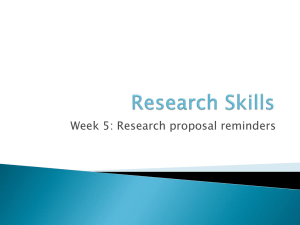Make your lab report better
advertisement
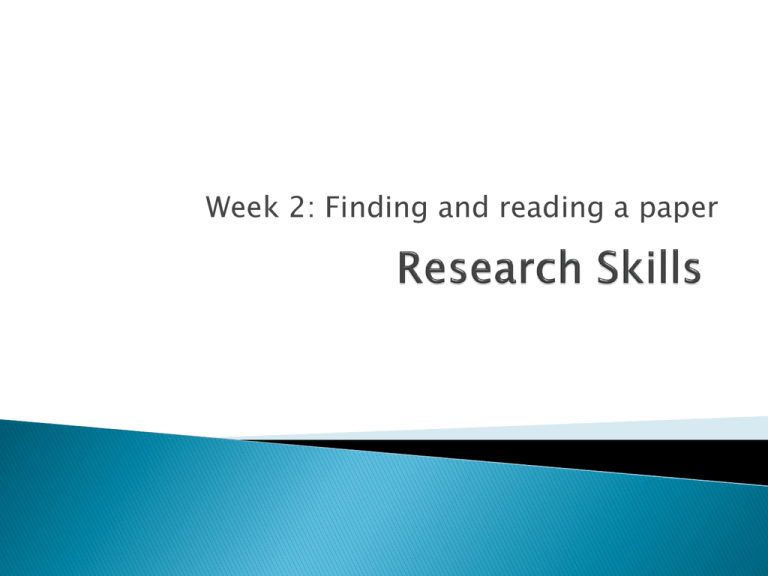
Week 2: Finding and reading a paper ◦ See StudyDirect for the names of your tutors ◦ Please remember our first names for submission of your course work ◦ Only email us for personal issues (e.g. to inform us of absence etc.) 1 hour practical Autumn term weeks 2-9 Please attend allocated sessions or negotiate a change directly with the Psychology office ◦ ◦ ◦ ◦ ◦ ◦ ◦ ◦ Week Week Week Week Week Week Week Week 2: 3: 4: 5: 6: 7: 8: 9: Finding and reading papers Designing a questionnaire How to write a research proposal SPSS – data entry and analysis Excel – how to make graphs How to write a lab report How to make a PowerPoint presentation Lab report Q & A Autumn term coursework submissions ◦ Week 6: Research Proposal (based on your questionnaire study) ◦ Week 9/10: Presentation of questionnaire findings to your personal tutor (by arrangement with them) ◦ Week 10: Lab report (write-up of questionnaire findings) Course material - Graham Hole’s resources page: ◦ Google > Graham Hole Questions about the course/coursework: ◦ Forum: Study Direct > Research Skills > Forum ◦ Office Hour: (to be announced) ◦ Emails: Do not email tutors directly about coursework, use the forum. The Research Process Research Proposals and Lab Reports Scientific Writing Style Research Proposal – Step-by-Step Original Article vs. Textbook How to Find a Paper How to Read a Paper Subject area Read around the subject Research question Design the study Research proposal Obtain ethical approval Conduct the study Data analysis Lab report Research Proposal ◦ Proposal to do a study ◦ Often written to apply for funding ◦ Contains title, introduction, and method ◦ Written in future tense (you still have to conduct the study) Lab report ◦ Report of a study that you have conducted ◦ Resembles structure of journal articles ◦ Contains title, abstract, introduction, method results and discussion ◦ Written in past tense (you are describing the results of your study) Write concisely Write in a formal tone Avoid Jargon Focus on relevant literature Top tip: Read and look at published journal articles to get an idea of what you should be aiming for Select a subject area 1. ◦ ◦ Keep it simple Check availability of literature on topic Read around the subject 2. ◦ ◦ What has been examined by others? What were their findings? Justifying your study 3. ◦ ◦ ◦ Find a gap in literature OR Find contrasting results from different studies Not so important for this term Research question 4. What will you examine in your study? For this term: Focus on differences between 2 groups (e.g. men vs. women/ meat consumers vs. vegetarians/ undergraduates vs. graduates/ etc.) ◦ ◦ For example: Do men have different exercise habits than women? Developing your hypotheses 5. ◦ ◦ ◦ What do you expect to find? How do you expect that the groups will differ from each other? Predictions should be based on previous findings from other authors (Step 2) Design the study 6. ◦ ◦ ◦ ◦ For this term: Questionnaire study Again, keep it simple You should be able to test your hypotheses with the questions you choose to use We’ll get back to this step next week From a textbook citation... “Stanley Milgram’s (1963) study of destructive obedience highlighted the dilemma facing a person ordered by an authority figure to perform an immoral act” But why would I want to look at the original? And if I did, how would I find it? I think Cuddy is very intelligent! One simple reason: When a textbook/paper author (or anyone else) summarises a study, they can get it wrong... The more people between you and the study, the more chance something is wrong Wilson House Wilson thinks you’re intelligent ...but ugly. House Cuddy At the end of textbook chapters (or sometimes the whole book) and journal articles you will find the reference section Reference sections are ordered by first author’s surname: Milgram, S. (1963). Behavioral study of obedience. Journal of Abnormal and Social Psychology, 67(4), 371–378. If you know the reference for a paper:◦ Go to the library website: www.sussex.ac.uk/library ◦ Electronic Library > Online Journals > Type in journal name > Find the correct volume, issue and page numbers If you want to do a search on a topic:◦ Go to the library website: www.sussex.ac.uk/library ◦ Electronic Library > Online Resources > Choose ‘PsycARTICLES’ or ‘PsycINFO’ > Simple or Advanced ◦ Electronic Library > QuickSearch ◦ Google Scholar Top tip: be specific! Papers are laid out in this order: Easier to read them in this order: ◦ Abstract ◦ Abstract ◦ Introduction ◦ Discussion ◦ Methods ◦ Introduction ◦ Results ◦ Methods ◦ Discussion ◦ Results ◦ References ◦ (References) Abstract ◦ Summary of everything that’s in the paper ◦ Order: Past research, methods, results, conclusions ◦ Approx. 150 words Discussion ◦ Summary of purpose and results ◦ Comparison to previous research ◦ Possible faults ◦ Wider implications ◦ Future directions ◦ Conclusions Introduction ◦ Quick explanation of research area ◦ Summary of relevant past research (and perhaps its flaws) ◦ Purpose of study ◦ Brief description of methods ◦ Hypotheses Methods ◦ Usually split into four sections: Participants Materials Design Procedure ◦ Technical language Results ◦ Point-by-point breakdown of findings ◦ Descriptive statistics ◦ Inferential statistics ◦ The magic word ‘significant’ References ◦ Don’t need to worry about these too much when reading ◦ If you find past research in the paper that sounds interesting, look for a full citation here ◦ And use your new skills to find that paper Get into groups of 4 Pick a topic, e.g.: ◦ Healthy lifestyle (for example): Exercise Smoking Eating habits Alcohol consumption ◦ University lifestyles ◦ Environmentally friendly behaviours Check with one of us that it’s okay Start finding and reading papers about the topic Read up to 5 papers on your chosen topic ◦ Try to read the same papers as others in your group ◦ Or read one or two papers and summarise to your group before next week Come to class next week with some ideas for questions you can ask people Keep it simple! Next week: Construct the questionnaire in class
